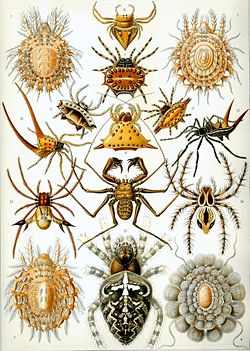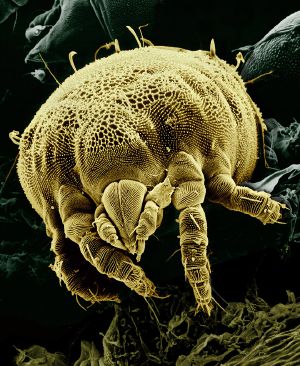Difference between revisions of "Arachnida" - New World Encyclopedia
({{Contracted}}) |
Rick Swarts (talk | contribs) |
||
| Line 5: | Line 5: | ||
| image = Haeckel Arachnida.jpg | | image = Haeckel Arachnida.jpg | ||
| image_width = 250px | | image_width = 250px | ||
| − | | image_caption = "Arachnida" from [[Ernst Haeckel]]'s '' | + | | image_caption = "Arachnida" from [[Ernst Haeckel]]'s ''Kunstformen der Natur'', 1904 |
| regnum = [[Animal]]ia | | regnum = [[Animal]]ia | ||
| phylum = [[Arthropod]]a | | phylum = [[Arthropod]]a | ||
| Line 15: | Line 15: | ||
See text. | See text. | ||
}} | }} | ||
| − | ''' | + | An '''arachnids''' is any member of the [[arthropod]] class '''Arachnida''', a largely terrestrial group that includes [[spider]]s, [[mite]]s, [[tick]]s, [[scorpion]]s, and [[opiliones|harvestmen]] (daddy longlegs). Arachnida is one of the classes of the subphylum Chelicerata (including [[horseshoe crabs, sea scorpions, and sea spiders) of the phylum Arthropoda. Arachnids are characterized by four pairs of segmented walking legs and a body divided into two regions, the cephalothorax and the abdomen. |
| − | Arachnids may be easily distinguished from [[insect]]s by the fact that arachnids have eight [[arthropod leg|legs]] whereas insects have six. The | + | ==Overview== |
| + | As [[arthropod]]s (phylum Arthropoda), the arachnids are characterized by the possession of a segmented body, a pair of jointed appendages on each segment, and an [[exoskeleton]]. The hard exoskeleton is made out of [[protein]] and a tough [[carbohydrate#polysaccharides|polysaccharide]] called [[chitin]]. Periodically, an arachnid must shed this covering when it [[ecdysis|molts]]. | ||
| + | |||
| + | As arthropods, arachnids are also characterized by a dorsal [[heart]], a ventral [[nervous system]], an open [[circulatory system]], and a [[digestive system]]. | ||
| + | |||
| + | The subphylum Chelicerata, to which arachnids belong, is one of the major subdivisions of the phylum Arthropoda. Most of the marine chelicerates are now [[extinct]]. In the Chelicerata, the body is divided into an anterior '''prosoma''' (or [[cephalothorax]]) composed of eight segments plus a presegmental acron and a posterior '''[[opisthoma]]''' (or ''abdomen''), composed of twelve segments plus a postsegmental [[telson]]. As in other arthropods, the mouth lies between the second and third segments, but whereas in other groups there is usually a pair of [[antenna (biology)|antennae]] on the last preoral segment, here there are none. The first two segments of the prosoma bear no appendages; the third bears the [[chelicerae]]. The chelicerae, which give the group its name, are pointed appendages that grasp the food in place of the chewing mandibles most other arthropods have. | ||
| + | |||
| + | [[Image:Yellow mite (Tydeidae) Lorryia formosa 2 edit.jpg|thumb|Yellow mite<br>''Lorryia formosa'']] | ||
| + | |||
| + | Arachnids may be easily distinguished from [[insect]]s by the fact that arachnids have eight [[arthropod leg|legs]] whereas insects have six. The chelicerae serve to macerate food particles. The first post-oral pair of appendages—pedipalps (leg-like [[mouthparts]])—of some species have been adapted for [[sensor]]y, [[predation|prey]] capture or [[reproduction|reproductive]] functions. In [[Solifugae]], the palpi are quite leg-like and make Solifugae appear to have ten legs. The [[larva]]e of mites have only six legs; the fourth pair appears when they [[ecdysis|molt]] into [[nymph (biology)|nymph]]s. Arachnids are further distinguished from insects by the fact they have no antennae and no wings. They have a two-segmented body, made up of a [[cephalothorax]] and an [[abdomen]], the cephalothorax being derived from the fusion of the [[cephalon]] (head) and the [[thorax]]. | ||
Arachnids are mostly [[carnivore|carnivorous]], feeding on the pre-digested bodies of insects and other small animals. Many are [[venom (poison)|venomous]] - they secrete [[poison]] from specialized glands to kill prey or enemies. Others are [[parasite]]s, some of which are carriers of [[disease]]. Arachnids usually lay [[egg (biology)|eggs]], which hatch into immature adults. | Arachnids are mostly [[carnivore|carnivorous]], feeding on the pre-digested bodies of insects and other small animals. Many are [[venom (poison)|venomous]] - they secrete [[poison]] from specialized glands to kill prey or enemies. Others are [[parasite]]s, some of which are carriers of [[disease]]. Arachnids usually lay [[egg (biology)|eggs]], which hatch into immature adults. | ||
| + | |||
| + | |||
| + | Arachnids are named after the [[Greek mythology|mythological]] figure [[Arachne]]. They are chiefly terrestrial [[arthropod]]s, comprising some 65,000 to 73,000 named [[species]] including [[spider]]s, [[scorpion]]s, [[opiliones|harvestmen]], [[tick]]s, and [[mite]]s. | ||
== Classification == | == Classification == | ||
| Line 61: | Line 73: | ||
[[Category:Life sciencs]] | [[Category:Life sciencs]] | ||
| − | {{credit|121185891}} | + | {{credit|Arachnida|121185891|Chelicerata|121569457}} |
Revision as of 21:31, 15 April 2007
| Arachnid | ||||||||
|---|---|---|---|---|---|---|---|---|
 "Arachnida" from Ernst Haeckel's Kunstformen der Natur, 1904
| ||||||||
| Scientific classification | ||||||||
| ||||||||
|
See text. |
An arachnids is any member of the arthropod class Arachnida, a largely terrestrial group that includes spiders, mites, ticks, scorpions, and harvestmen (daddy longlegs). Arachnida is one of the classes of the subphylum Chelicerata (including [[horseshoe crabs, sea scorpions, and sea spiders) of the phylum Arthropoda. Arachnids are characterized by four pairs of segmented walking legs and a body divided into two regions, the cephalothorax and the abdomen.
Overview
As arthropods (phylum Arthropoda), the arachnids are characterized by the possession of a segmented body, a pair of jointed appendages on each segment, and an exoskeleton. The hard exoskeleton is made out of protein and a tough polysaccharide called chitin. Periodically, an arachnid must shed this covering when it molts.
As arthropods, arachnids are also characterized by a dorsal heart, a ventral nervous system, an open circulatory system, and a digestive system.
The subphylum Chelicerata, to which arachnids belong, is one of the major subdivisions of the phylum Arthropoda. Most of the marine chelicerates are now extinct. In the Chelicerata, the body is divided into an anterior prosoma (or cephalothorax) composed of eight segments plus a presegmental acron and a posterior opisthoma (or abdomen), composed of twelve segments plus a postsegmental telson. As in other arthropods, the mouth lies between the second and third segments, but whereas in other groups there is usually a pair of antennae on the last preoral segment, here there are none. The first two segments of the prosoma bear no appendages; the third bears the chelicerae. The chelicerae, which give the group its name, are pointed appendages that grasp the food in place of the chewing mandibles most other arthropods have.
Arachnids may be easily distinguished from insects by the fact that arachnids have eight legs whereas insects have six. The chelicerae serve to macerate food particles. The first post-oral pair of appendages—pedipalps (leg-like mouthparts)—of some species have been adapted for sensory, prey capture or reproductive functions. In Solifugae, the palpi are quite leg-like and make Solifugae appear to have ten legs. The larvae of mites have only six legs; the fourth pair appears when they molt into nymphs. Arachnids are further distinguished from insects by the fact they have no antennae and no wings. They have a two-segmented body, made up of a cephalothorax and an abdomen, the cephalothorax being derived from the fusion of the cephalon (head) and the thorax.
Arachnids are mostly carnivorous, feeding on the pre-digested bodies of insects and other small animals. Many are venomous - they secrete poison from specialized glands to kill prey or enemies. Others are parasites, some of which are carriers of disease. Arachnids usually lay eggs, which hatch into immature adults.
Arachnids are named after the mythological figure Arachne. They are chiefly terrestrial arthropods, comprising some 65,000 to 73,000 named species including spiders, scorpions, harvestmen, ticks, and mites.
Classification
- Trigonotarbida - extinct
- Amblypygi - "blunt rump" tailless whip scorpions with front legs modified into whip-like sensory structures as long as 25 cm or more
- Araneae - spiders (40,000 species)
- Mesothelae - very rare, basal spiders, with abdomen segmented and spinnerets median
- Opisthothelae - spiders with abdomen unsegmented and spinnerets located posteriorly
- Araneomorphae - most common spiders
- Mygalomorphae - tarantulas and tarantula-like spiders
- Phalangiotarbida - extinct
- Opiliones - phalangids, harvestmen or daddy-long-legs (6,300 species)
- Palpigradi - microwhip scorpions
- Pseudoscorpionida - pseudoscorpions
- Ricinulei - ricinuleids, hooded tickspiders
- Schizomida - "split middle" whip scorpions with divided exoskeletons
- Scorpiones - scorpions (2,000 species)
- Solifugae - solpugids, windscorpions, sun spiders or camel spiders (900 species)
- Haptopoda - extinct
- Uropygi - whip scorpions, with first legs modified as whip-like sensory organs and with a long thin tail at end of abdomen (100 species)
- Acarina - mites and ticks (30,000 species)
- Acariformes
- Sarcoptiformes
- Trombidiformes
- Opilioacariformes
- Parasitiformes - holothyrans, ticks and mesostigmatic mites
- Acariformes
Arachnida in human culture
Arachnids since ancient times have captured the human imagination, for example as objects of superstitious fear. They make their appearance in the Western zodiac, in the constellation of Scorpius. They are also present in the Egyptian hieroglyphs and diverse mythological characters such as the Greek Arachné and the west African Anansi. There are a number of gods based on arachnids, such as the Egyptian Serket. Images of scorpion-men are present in Assyrian reliefs.
See also
- Tarantulas.us - Forums - Tarantula Discussion Boards and Caresheets.
- Tarantulas.us - Gallery - The largest photo gallery of all tarantula's species.
- Tarantula Tour
- List of scorpion common names
- Arachnophobia
- List of spider common names
Credits
New World Encyclopedia writers and editors rewrote and completed the Wikipedia article in accordance with New World Encyclopedia standards. This article abides by terms of the Creative Commons CC-by-sa 3.0 License (CC-by-sa), which may be used and disseminated with proper attribution. Credit is due under the terms of this license that can reference both the New World Encyclopedia contributors and the selfless volunteer contributors of the Wikimedia Foundation. To cite this article click here for a list of acceptable citing formats.The history of earlier contributions by wikipedians is accessible to researchers here:
The history of this article since it was imported to New World Encyclopedia:
Note: Some restrictions may apply to use of individual images which are separately licensed.
